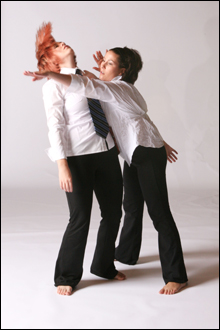
ANTI-WAR MOVEMENT: Gamba and
Gehman in Curve Ball. |
Now in its 21st season, Fusionworks Dance Company has always presented a variety of contemporary pieces by a wide range of choreographers, with an emphasis on the work of artistic director Deb Meunier. Their spring concert at Brown University’s Ashamu Dance Theater (March 27 through 29) is no exception, with three dances by Meunier, one by local choreographer Laura Bennett, one by company member Anne Gehman, and a collaborative piece by Stephanie Stanford Shaw and the members of Fusionworks II, the junior company.
This show, portions of it previewed at a rehearsal last week, starts off with the Fusionworks II piece, based on the dancers’ impressions of a “life-changing event” and built around the music of Keiko Matsui.
It’s followed by the anti-war Curve Ball, which Meunier premiered last fall. Set to the Nine Inch Nails song “Survivalism” and titled after the Iraqi informant, the duet (Melody Gamba and Anne Gehman) is a fierce condemnation of “the guys in the blue suits,” according to Meunier, who led us to a situation where “nobody wins! It’s a vicious dead end.”
The dancers have white shirts, black pants, and ties, but they become more disheveled as their “negotiations” proceed. Each of them holds a nondescript cloth doll which they grab back and forth from one another. Sometimes they throw out karate kicks, sometimes they march in lockstep. At one point, Gamba yells “No! No! No! No!” This dance is a political sucker punch, a first from Meunier.
For a complete change of mood, she reprises two parts of her homage to Tom Jones, Oh, Tom, You Naughty, Naughty Boy, described by Meunier as a “glam, fun, sexy romp.” The first part, to Jones’s interpretation of Prince’s “Kiss,” was choreographed with Brooke Young. The second, set to Jones’s adaptation of Leadbelly’s “Black Betty,” was Meunier on her own.

It opens on a frieze of seven dancers — Amy Bardenhagen, Amy Burns, Shauna Edson, Gamba, Gehman, Sheramy Keegan-Turcotte, and Stephanie Stanford Shaw — with tons of attitude, beginning to snap their fingers in time, rock their heads, and sway their torsos to the instrumental intro before they break out into jazzy, sassy moves to match the lyrics. All six, in black pants and hot pink bustiers, get into the loaded looks, the sideways sneers, the come-hither glances. Gamba solos with a strut toward the audience, hands running down her hair, and then a blown kiss.
For a new piece, The Distant Aidenn (from Edgar Allan Poe’s “The Raven”), Meunier has dipped into three solos from 1986, created when she was going through a sad and reflective transitional time. She wanted to show that each of the three who represented a different part of a person had come together to make the whole person she is today.
Choreographed to the rippling arpeggios and dramatic pauses of George Winston’s piano solos, the three dancers interact in different permutations of solos and duets. Keegan-Turcotte is holding her sorrow close to her, her back to the audience as the piece begins; Gehman runs across the floor as if fleeing her emotions; Bardenhagen is trapped by her anguish, her shoulders curled in despair. But at the end, the three touch once more and hold the pose.
Gehman’s piece is the frightening, disturbing Surveillance: Exhibit A, inspired by George Orwell’s 1984 and by the proliferation of surveillance cameras in today’s society. Three dancers enter the stage with black blindfolds; two others sit on metal chairs, which are slid back and forth. There is one poig¬nant moment, when two of the five try to comfort each other, but they are both so paranoid of being watched that their anxiety is not eased.
Once again, a serious, message-laden dance is followed by a lighter one, this time Bennett’s Mynah Riff, to the music of Duke Ellington’s “Far East Suite.” Bennett has described its three movements as “getting ready, doing the performance, and the dancers going out afterwards to eat and drink.” The six dancers give us undulating movement that follows the sax riffs, skips and leaps to the backbeat, hands doing air-drumming. It’s a joyful celebration of the Ellington era.